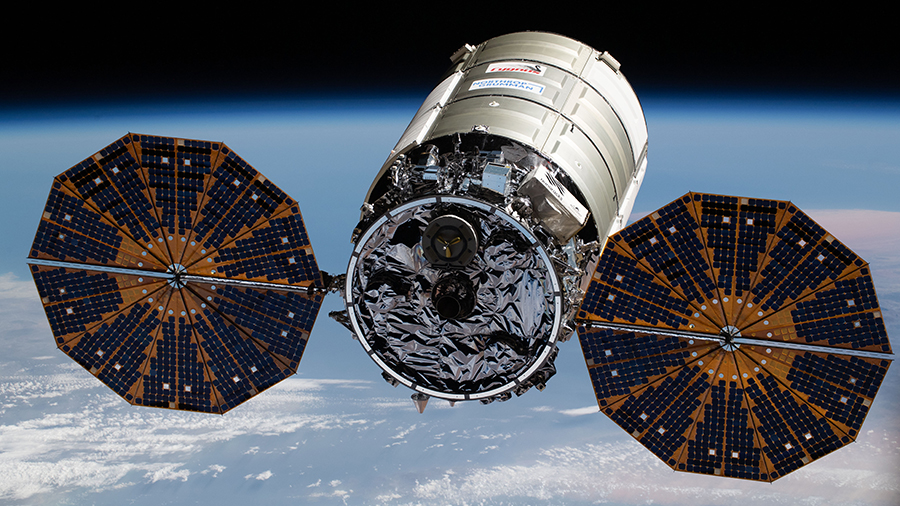Life Science, Debris Avoidance Maneuver Takes Place on Station

Life Science, Debris Avoidance Maneuver Takes Place on Station
The Expedition 67 crew studied advanced physics, continued its human research, and worked on space gardening inside the International Space Station on Thursday. The orbital residents are also readying the Cygnus space freighter for its departure next week.
NASA Flight Engineer Jessica Watkins split her day between physics research hardware and sample processing. She stowed components from the Transparent Alloys industrial manufacturing experiment and returned the Microgravity Science Glovebox to its standard configuration. Watkins also collected blood and urine samples throughout the day and stowed them in a science freezer for future analysis.
Space botany and fluid physics were on the research schedule as well for Flight Engineers Kjell Lindgren of NASA and Samantha Cristoforetti of ESA (European Space Agency). Lindgren nourished radishes and mizuna greens growing for the XROOTS hydroponics and aeroponics study. Cristoforetti ran a pair of experiment sessions for the Fluidics study that is exploring how fuel behaves in microgravity.
NASA astronaut Bob Hines worked on communications hardware and serviced centrifuge components inside the Human Research Facility. Hines also worked throughout the day with Lindgren, Watkins, and Cristoforetti loading the Cygnus resupply ship with trash and discarded gear ahead of its departure on June 23. NASA TV will broadcast Cygnus’ release from the Canadarm2 robotic arm on the agency’s app and website.
The orbiting lab’s three cosmonauts focused on their complement of research today exploring how to improve space operations. Commander Oleg Artemyev and Flight Engineer Sergey Korsakov took turns participating in an investigation that may inform piloting and robotics control techniques on future planetary missions. Flight Engineer Denis Matveev set up dosimeters for a long-running radiation detection experiment before removing a sensor that monitored his heart activity for 24 hours.
This afternoon, the International Space Station’s Progress 81 thrusters fired for 4 minutes, 34 seconds in a Pre-Determined Debris Avoidance Maneuver (PDAM) to provide the complex and extra measure of distance away from the predicted track of a fragment of Russian Cosmos 1408 debris.
The thruster firing occurred at 2:03 p.m. Central time. The crew was never in any danger and the maneuver had no impact on station operations.
Without the maneuver, it was predicted that the fragment could have passed within around a half mile from the station.
The PDAM increased the station’s altitude by 3/10 of a mile at apogee and 7/10 of a mile at perigee and left the station in an orbit of 261.2 x 257.3 statute miles.
The scheduled reboost of the station on Saturday to test Northrop Grumman’s Cygnus NG-17 vehicle’s reboost capability for the first time will still be conducted, but with a slightly reduced engine firing duration to preserve the phasing for Russian Soyuz launch and landing operations in September.
On Saturday, June 18, the Cygnus spacecraft will perform its first limited reboost of the International Space Station. Cygnus’s gimbaled delta velocity engine will be used to adjust the space station’s orbit through a reboost of the altitude of the space station. This Cygnus mission is the first to feature this enhanced capability as a standard service for NASA, following a test of the maneuver which was performed in 2018 during Cygnus’s ninth resupply mission. Cygnus arrived to the orbital outpost in February and is slated to depart from space station later this month where it will burn up harmlessly in the Earth’s atmosphere.
Learn more about station activities by following the space station blog, @space_station and @ISS_Research on Twitter, as well as the ISS Facebook and ISS Instagram accounts.
Get weekly video highlights at: http://jscfeatures.jsc.nasa.gov/videoupdate/
Get the latest from NASA delivered every week. Subscribe here: www.nasa.gov/subscribe
from Space Station https://ift.tt/TYt3bzk
Comments
Post a Comment